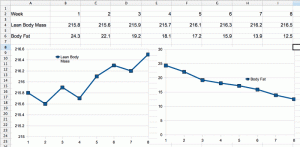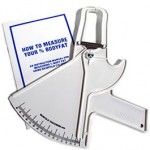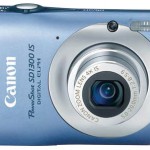Measuring Progress
So, how do you know if your bodybuilding is going well? In the short term, say less than 2 months, the best way to measure your progress is with a logbook. Make a note of every exercise you do, what weight you use and how many reps you did on each set. If you can do two more reps after a month or can increase the weight you are lifting then you are making progress.
To measure your true progress you need to be able to chart how your body’s muscle mass and fat mass varies week to week. There are two pieces of equipment you need, first a scale, preferably a mechanical balance beam scale. Weighing yourself accurately is more difficult than it sounds but doesnt require any fancy equipment. The second thing you need is an inexpensive skinfold caliper. The skinfold caliper is the cheapest and most accurate way to measure bodyfat, digital devices to measure bodyfat are expensive an inaccurate. An accurate plastic skinfold caliper costs about $20. Now lets look at how you use these two tools to chart your progress. First, weigh yourself daily at the same time – best is first thing in the morning before eating or drinking anything. Second, use the skinfold thickness calipers and my body composition calculator to find how much muscle and fat you have on your body so you can chart it. Then use a spreadsheet or graph paper to track your progress you can download the below illustrated spreadsheet here.
The video below explains how to use the skinfold calipers and the calculator on my website to determine your lean body mass and your bodyfat.
Scales
Using the bathroom scale is problematic, especially cheap digital scales – please check out my article on how to accurately weigh yourself – its more difficult than it sounds. Digital scales are temperature sensitive and many are wildly inaccurate despite the fact that they report the weight to within .1 pound. If your weight is going up, are you gaining fat or muscle? If your weight is going down, are you losing fat or muscle? A mistake that many beginning bodybuilders make is to weight themselves daily and worry about day to day fluctuations. Remember that most hard working bodybuilders will only be able to add 5-10 lbs of muscle a year (see expectations), that means gaining only 2 ounces of muscle a week. There is NO way you can accurately measure the addition of 2 ounces of muscle because one salty meal can make you instantly retain 5lbs of water. For most people, measuring weight daily un-necessarily de-motivates. You are trying to lose weight and the scale says you gained 3 pounds overnight so you decide its all a waste of time and have two big macs for lunch.
Scales are notoriously inaccurate and besides, one salty meal can make you ‘gain’ 5 lbs but its not fat just water so don’t let it de-motivate you. If you are eating well, feeling good and working out regularly you will lose fat and gain muscle, just give it time. At the start of the year, weigh yourself, measure your body fat with calipers, and take your measurements with a tape measure – then put away the calipers and tape measure till next year. If you feel good, you look good – don’t let some arbitrary needle on a scale determine how you feel about yourself. Having said that, a scale can be a great progress measuring device in the long term, say greater than 6 months. A scale in conjunction with your bodyfat percentage can let you track your Lean Body Mass (LBM) which is a great way to track the amount of muscle you are adding.
Tape Measure
Another good way to check progress is the tape measure, for muscle mass we will measure the circumference of the biceps as that is very easy to measure consistently – just make sure you measure it the same way each time and look in the mirror when you do it. The biceps measurement will give us a gauge of muscle mass but this isn’t the whole picture because our biceps would get bigger arms if we ate 10 big macs and didn’t work out at all too. Now we will measure the waist and this will tell us if we have gained or lost fat. For this measurement, anything is fair so do whatever you can to make the measurement as small as possible. So with these two measurements we can tell how we are doing. If our waist measurement goes down and our biceps measurement goes up we are doing great and there is no reason at all to use a scale or bother with calipers.
Measure yourself two to four times a year but remember, it takes a long time to put on muscle so don’t expect more than a fraction of an inch on your arms in a year Remember, its the trend that is important not the actual number. You can buy a flexible tape measure at a fabric store or click here to buy it from amazon. The tape measure is not a good tool for measuring gains in the short term because the changes are so small. The tape measure is only useful in monthly or yearly measurements, it is not useful for short term progress measurements.
Skinfold Caliper
What if your arm gets 1/2″ bigger and your waist gets 1/2″ bigger, how you are doing is a bit less clear because you have gained muscle and some fat. In this case you need body fat calipers can clear things up. Again, make sure you take the caliper measurement in exactly the same place each time and measure – for example, “one inch to the left of the belly button”. Take the measurement five or six times and make sure you get the same each time before writing it down. The caliper set shown to the left is widely available for about $20 so its a good investment. The booklet it comes with gives detailed instructions on how to measure body fat.
A warning though, what we care about is only the thickness of the layer of fat covering the body – not the actual body fat percentage so don’t waste any time using their tables to convert your measurements into a body fat number. You can click here to buy an accurate spring force caliper from amazon, or you can get the entire kit that has a little booklet on how to measure body fat too. I wouldn’t buy the cheaper variety as the results are not accurate. If you are really serious about knowing minute variations in your body fat then you need a professional skin fold caliper but at $200 you need to be really serious to an instrument like this. You can see how to use your skinfold calipers to calculate your bodyfat percentage.
Camera
Finally, the most direct form of progress measurement is a digital camera. A cell phone camera can provide this cheaply. Somebody in your family probably has a good digital camera you could borrow once a month. I use the Canon Powershot SD1300IS and love it. I use it to make all my movies and take all my still photos. At $170 its a camera bargain.





